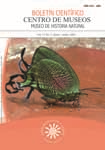Authors
Abstract
This study examines the relation between the intraspecific aggressiveness level of the polygynous ant Crematogaster longispina, and the distance separating white yarumo trees (Cecropia telealba), this species’ habitat. In addition, it investigates whether the degree of interspecific hostility between C. longispina and Myrmelachista sp. has differences. The aggressiveness level was measured through the observation of encounters between worker ants, graded according to an aggressiveness scale. There were differences in the intraspecific aggression degree, but not in the interspecific one. No correlation was found between the intraspecific aggression level and the distance between trees. The measurement of other variables that could better explain the differences in intraspecific aggression levels is suggested. The variation in the intraspecific hostility can be better understood if studies on the genetic structure of colonies are conducted.
References
BEYE, M., NEUMANN, P., CHAPUISAT, M., PAMILO, P. & MORITZ, R.F.A., 1998. Nestmate recognition and the genetic relatedness of nests in the ant Formica pratensis. Behavioral Ecology and Sociobiology, 43: 67-72.
CARLIN, N.F. & JOHNSTON, A.B., 1984. Learned enemy specification in the defense recruitment system of an ant. Naturwissenschaften, 71 (3): 156-157.
CASSINI, M.H., 1999a. Etología y conservación: un encuentro con futuro. Etología, 7: 1-4.
__________., 1999b. Importancia de la etología en la Conservación. Etología, 7: 69-75.
CROSLAND, M.W.J., 1990. Variation in ant aggression and kin discrimination ability within and between colonies. Journal of Insect Behavior, 3: 359– 379.
DAWKINS, R., 1976/1993. El gen egoísta: Las bases biológicas de nuestra conducta. Barcelona: Salvat.
DEJEAN, A., CORBARA, B., FERNÁNDEZ, F. & DELABIE, J.H.C., 2003. Mosaicos de hormigas arbóreas en bosques y plantaciones tropicales: 149-158 (en) FERNÁNDEZ, F. (ed.) Introducción a las Hormigas de la región Neotropical. Bogotá: Instituto de Investigación de Recursos Biológicos Alexander Von Humboldt.
DELABIE, J.H.C., OSPINA, M. & ZABALA, G., 2003. Relaciones entre hormigas y plantas: una introducción: 167-180 (en) FERNÁNDEZ, F. (ed.) Introducción a las Hormigas de la región Neotropical. Bogotá: Instituto de Investigación de Recursos Biológicos Alexander von Humboldt.
FEENER, D.H., 1986. Alarm-recruitment behaviour in Pheidole militicida (Hymenoptera: Formicidae). Ecological Entomology, 11 (1): 67-74
__________., 1987. Response of Pheidole morrisi to two species of enemy ants, and a general model of defense behavior in Pheidole (Hymenoptera: Formicidae). Journal of the Kansas Entomological society, 60 (4): 569-575.
HEINZE, J., FOITZIK, S., HIPPERT, A. & HÖLLDOBLER, B., 1996. Apparent dear-enemy phenomenon and environment-based recognition cues in the ant Leptothorax nylanderi. Ethology, 102: 510-520.

 PDF (Español)
PDF (Español)
 FLIP
FLIP


















